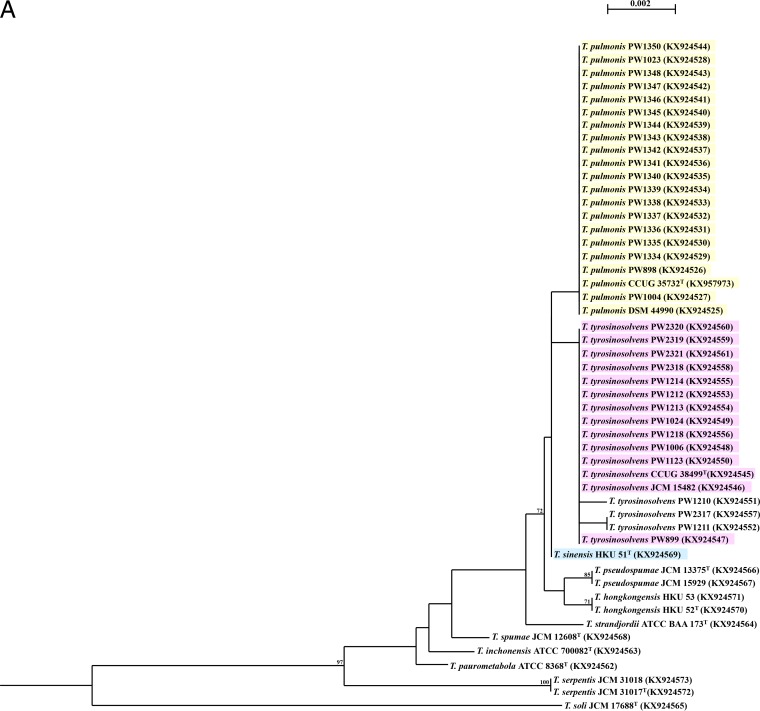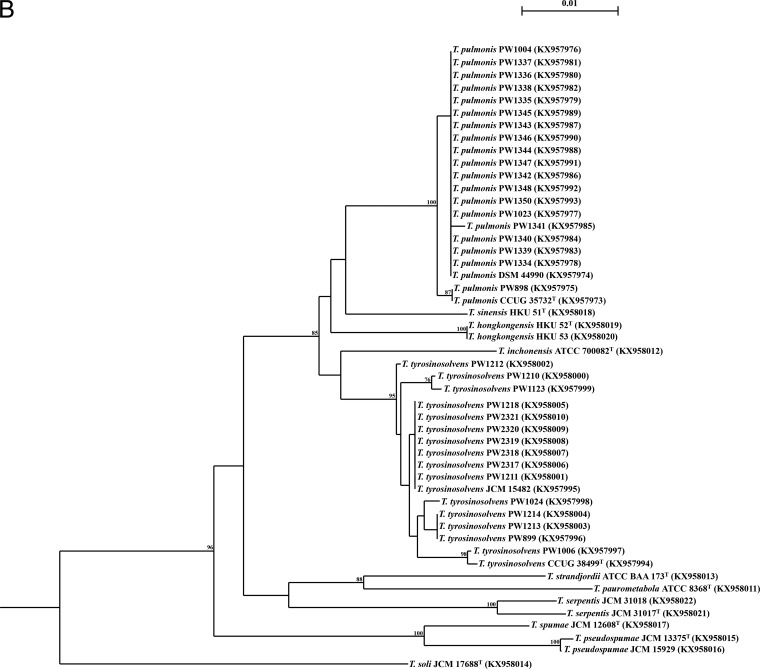LETTER
Differentiation of Tsukamurella from the other related genera, such as Nocardia, Rhodococcus, and Gordonia, and species-level identification within these genera have been difficult in most clinical microbiology laboratories, as they share similar phenotypic properties. Among various molecular methods, 16S rRNA gene sequencing has been the most widely used for bacterial identification, especially in cases where bacterial isolates are difficult to identify by phenotypic tests. However, previous studies showed that most Tsukamurella species share highly similar 16S rRNA gene sequences (>99% nucleotide identities), and thus this gene target cannot be confidently used for the identification of these species (1). Examples of alternative gene targets, such as ssrA (stable small RNA), secA (the secretion ATPase), rpoB (beta-subunit of RNA polymerase), and groEL (heat shock protein 60), have been used successfully for species-level identification in other bacterial genera (2–5). However, the usefulness of these gene targets for species-level identification of Tsukamurella is not known.
In this study, we sequenced five gene targets (16S rRNA, ssrA, secA, rpoB, and groEL) from 16 type and reference strains of all currently recognized Tsukamurella species and evaluated their usefulness for species-level identification (Table 1). The complete set of primer sequences and the PCR conditions are shown in Table S1 in the supplemental material. Among the five gene targets, ssrA, secA, and rpoB failed to differentiate between strains of different species or to show the same clustering for strains of the same species (results were shown in Table S1 and Fig. S1 in the supplemental material). Since only 16S rRNA and groEL gene sequences were able to show correct species assignments, the usefulness of these two gene targets was further evaluated by determining their sequences in 34 additional clinical (n = 18) and veterinary (n = 16) isolates, and their species identities (15 were T. tyrosinosolvens and 19 were T. pulmonis) were confirmed by DNA-DNA hybridization (DDH) (6, 7). The interspecies similarities of 16S rRNA sequences of all 50 Tsukamurella isolates (16 type and reference strains and 34 clinical isolates) ranged from 96.7 to 99.9%, whereas those of groEL gene sequences ranged from 91.1% to 98.2% (Fig. 1). The intraspecies identities of 16S rRNA ranged from 99.9% to 100%, whereas those of the groEL gene ranged from 98.7% to 100.0% (Fig. 1). Although both the 16S rRNA and groEL gene sequences were able to correctly identify the 16 type and reference strains, when the 34 additional clinical isolates were included to evaluate their usefulness, the 16S rRNA gene failed to differentiate T. sinensis from some strains of T. pulmonis and T. tyrosinosolvens, showing up to 99.9% sequence similarities between two different Tsukamurella species. On the other hand, using a threshold value of 98.2% based on the groEL gene sequence, species identities of all 50 Tsukamurella strains were completely concordant with those determined by the gold standard, DDH, suggesting that this threshold value may be useful for species-level identification in Tsukamurella.
TABLE 1.
Bacterial strains and accession numbers
FIG 1.
Phylogenetic trees showing the relationship of the 50 Tsukamurella isolates (16 type and reference strains and 34 clinical isolates) inferred from partial 16S rRNA (1,221 nucleotide positions) (A) and groEL (677 nucleotide positions) (B) sequence data by the maximum likelihood method using the model GTR + I + G and Mycobacterium smegmatis MC2 155 (CP001663.1) as the outgroup. The scale bar indicates the estimated number of substitutions per base. Numbers at nodes indicate levels of bootstrap support calculated from 1,000 trees and expressed as percentages. Species shaded in the same color represent high sequence similarities (≥99.9%) between two different Tsukamurella species. All sequences obtained from this study and accession numbers are given as cited in the GenBank database.
In conclusion, we showed that the performance of groEL gene sequencing for species-level identification of Tsukamurella was better than that of 16S rRNA gene sequencing. Further study using additional clinical isolates belonging to species other than T. pulmonis and T. tyrosinosolvens will be necessary to thoroughly evaluate the usefulness of the groEL gene and its threshold value (98.2%) for species-level identification of Tsukamurella.
Accession number(s).
The sequence data of the 16S rRNA (1,221 nucleotide positions) and groEL (677 nucleotide positions) genes obtained in this study have been submitted to GenBank with accession no. KX924524 to KX924573 and KX957973 to KX958022, respectively. The sequence data of ssrA (366 nucleotide positions), secA (607 nucleotide positions), and rpoB (284 nucleotide positions) obtained in this study (see Fig. S1A to C in the supplemental material) have been submitted to GenBank with accession no. KX931996 to KX932011, KX931980 to KX931995, and KX932012 to KX932027, respectively.
Supplementary Material
ACKNOWLEDGMENTS
This work was partly supported by the Strategic Research Theme Fund, the Small Project Fund, The University of Hong Kong, and by a Croucher Senior Medical Research Fellowship, Croucher Foundation, Hong Kong.
Footnotes
Supplemental material for this article may be found at https://doi.org/10.1128/JCM.02260-16.
REFERENCES
- 1.Woo PC, Ng KH, Lau SK, Yip KT, Fung AM, Leung KW, Tam DM, Que TL, Yuen KY. 2003. Usefulness of the MicroSeq 500 16S ribosomal DNA-based bacterial identification system for identification of clinically significant bacterial isolates with ambiguous biochemical profiles. J Clin Microbiol 41:1996–2001. doi: 10.1128/JCM.41.5.1996-2001.2003. [DOI] [PMC free article] [PubMed] [Google Scholar]
- 2.Conville PS, Zelazny AM, Witebsky FG. 2006. Analysis of secA1 gene sequences for identification of Nocardia species. J Clin Microbiol 44:2760–2766. doi: 10.1128/JCM.00155-06. [DOI] [PMC free article] [PubMed] [Google Scholar]
- 3.Osawa K, Shigemura K, Shirai H, Kato A, Okuya Y, Jikimoto T, Arakawa S, Fujisawa M, Shirakawa T. 2015. Bacterial identification using ssrA encoding transfer-messenger RNA. Southeast Asian J Trop Med Public Health 46:720–727. [PubMed] [Google Scholar]
- 4.Adékambi T, Shinnick TM, Raoult D, Drancourt M. 2008. Complete rpoB gene sequencing as a suitable supplement to DNA-DNA hybridization for bacterial species and genus delineation. Int J Syst Evol Microbiol 58:1807–1814. doi: 10.1099/ijs.0.65440-0. [DOI] [PubMed] [Google Scholar]
- 5.Hossain MT, Kim EY, Kim YR, Kim DG, Kong IS. 2012. Application of groEL gene for the species-specific detection of Vibrio parahaemolyticus by PCR. Lett Appl Microbiol 54:67–72. [DOI] [PubMed] [Google Scholar]
- 6.Teng JL, Tang Y, Wong SS, Ngan AH, Huang Y, Tsang CC, Choi GK, Lau SK, Woo PC. 2016. Tsukamurella hongkongensis sp. nov. and Tsukamurella sinensis sp. nov., isolated from patients with keratitis, catheter-related bacteraemia and conjunctivitis. Int J Syst Evol Microbiol 66:391–397. doi: 10.1099/ijsem.0.000733. [DOI] [PubMed] [Google Scholar]
- 7.Seong CN, Kim YS, Baik KS, Choi SK, Kim MB, Kim SB, Goodfellow M. 2003. Tsukamurella sunchonensis sp. nov., a bacterium associated with foam inactivated sludge. J Microbiol 41:83–88. [Google Scholar]
Associated Data
This section collects any data citations, data availability statements, or supplementary materials included in this article.




